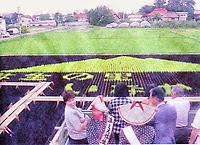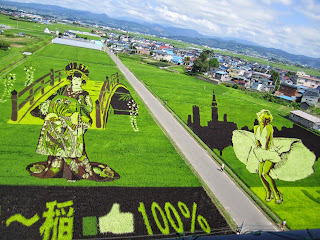(Jump to 2015 Inakadate Rice Field Art information)
Inakadate has a long history relating to rice. The site of an ancient rice field dating back to the mid-Yayoi Period (300 B.C.~300 A.D.), the Tareyanagi Iseki (Tareyanagi Site) was discovered in Inakadate in 1981. This was a significant find as until its discovery, it had been believed that rice fields were not cultivated in Tohoku during the Yayoi Period. The Tareyanagi Iseki was designated a National Historic Site on April 11, 2000.
Tareyanagi Iseki: Yayoi Rice Field Site
(Photo Source: Inakadate Buried Cultural Property Center & Museum)
To celebrate and promote its history of rice production, Inakadate began offering rice planting experience tours. In order to make the experience more interesting, they decided to use different coloured rices to draw a picture of Mt. Iwaki with the words 弥生の里いなかだて (Yayoi no sato Inakadate) meaning "Yayoi Village Inakadate." This was the humble beginning of rice field art--although at the time it was not referred to as "art" but simply as "rice characters" (稲文字 ine moji).
1993 "Yayoi Village Inakadate"
(Source: Mutsu Sinpou)
From 1993-2002, the design for the "rice characters" remained mostly unchanged apart from the addition of a moon to the design in 2002. The ambitious "Mona Lisa" design in 2003 marked the change from "rice characters" to "rice field art."
In response to criticisms about the Mona Lisa "looking fat" when viewed from the 6th floor viewing platform of the Inakadate Village Office rather than from overhead, from 2004 the designs for the rice field art were made on the computer to correct for the distortion caused by the viewing angle.
2003 "Mona Lisa" views from overhead & from viewing platform
(Picture Source: NTV)
Since 2004 the drastic improvement in technological and artistic levels have made Inakadate's rice art an increasingly popular site for both domestic and international tourists.
Inakadate's rice field art has proved so popular that in 2012, a second rice field art site was started at the Michi no Eki (Roadside Station) Inakadate "Yayoi no Sato."
Sources:
Inakadate Buried Cultural Property Center & Museum, "Tareyanagi Iseki tte naani" (Japanese): http://www.vill.inakadate.lg.jp/_common/themes/inakadate/maibun_hp/index.html
Mutsu Shinpou, "Inakadate-mura tanbo art 20-nen no ayumi" (Japanese): http://www.mutusinpou.co.jp/index.php?cat=54
Inakadate Tanbo Art (Japanese): http://homepage3.nifty.com/malus~pumila/minisight/inakadate/
2015 Inakadate Rice Field Art
第23回田舎館村田んぼアート (dai nijuusan kai Inakadate-mura tanbo art)
(Back to Inakadate Rice Field Art History)
The theme for this year's rice field art is "Gone with the Wind" for the main site and "Star Wars" for the second site (Michi no Eki Inakadate "Yayoi no Sato"). (The actual Star Wars design has yet to be announced.)
Date: June 1, 2015 (Mon.) - October 12, 2015 (Mon.)
(Recommended viewing period: Mid-July to Mid-August)
Time: Jun. 1-30, Sep. 1-Oct. 12: 9:00-17:00 (16:30 last entry)
Jul. 1-Aug. 31: 8:30-18:00 (17:30 last entry)
*Oct. 4, 2015 (Sun.) Site 1 will be closed for a rice harvesting tour*
Location(s):
- Rice Field Art Site 1: Inakadate Viewing Platform (Village Office) (第1田んぼアート田舎館村展望台(田舎館村役場)) (Map)
- Rice Field Art Site 2: Michi no Eki "Yayoi no Sato" (Yayoi no Sato Viewing Area) (第2田んぼアート道の駅いなかだて「弥生の里」(弥生の里展望所)) (Map)
Admission Procedures for Rice Field Art Site 1 (Japanese explanation here):
- Get an admission time ticket (整理券 seiriken)
- Line up in front of the entrance at the time printed on the ticket
- Purchase ticket(s) at the first floor ticket machines upon entering the building
- Line up for the elevator to the 4th floor (you will have to take stairs up to the viewing platform on the 6th floor)
- Waiting times of over 1 hour are expected for the Rice Field Art Site 1 Viewing Platform
- A free shuttle bus (max. occ. 9 people) between Sites 1 & 2 will be in operation from June 20
- Eating and drinking is only allowed on the 4th floor of the Inakadate Viewing Platform. Eating and drinking anywhere else within the buildings is prohibited.
- Smoking within the buildings is prohibited.
- Use of tripods in the viewing platforms is prohibited.
Train Access:
Tokyo Station to Shin-Aomori Station (Tohoku Shinkansen)
↓
Shin-Aomori Station to Hirosaki Station (JR Ou Line or Tsugaru Limited Express)
↓
Hirosaki Station to Tanbo Art Station (Konan Tetsudo)
Rice Field Art Site 1: Inakadate Viewing Platform (Village Office)
第1田んぼアート田舎館村展望台(田舎館村役場)
Nakatsuji-123-1 Inakadate
Minamitsugaru District, Aomori 038-1113
0172-58-2111
Rice Field Art Site 2: Michi no Eki "Yayoi no Sato" (Yayoi no Sato Viewing Area)
第2田んぼアート道の駅いなかだて「弥生の里」(弥生の里展望所)
Yahata-10 Takahi Inakadate Minamitsugaru District, Aomori 038-1111
0172-58-4411
More Information:
Inakadate Village Official Homepage (Japanese): http://www.vill.inakadate.lg.jp/docs/2013050200014/







Is the rice harvested for food?
ReplyDelete